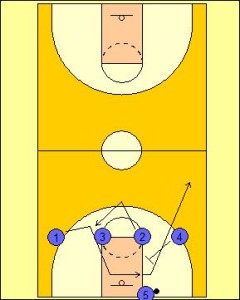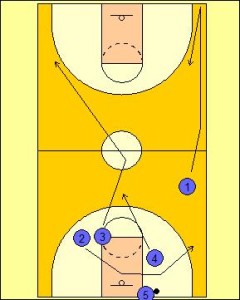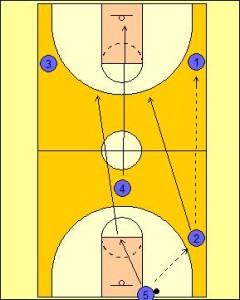Press Breaker: 1-4 Circle Cut
A Press Breaker helps bring peace of mind to players on the court when they are experiencing a high level of pressure from full court defence. The Press Breaker 1-4 Circle Cut Play is specially designed for when teams are facing a high-pressure situation using man-to-man defensive principles. The Press Breaker 1-4 Circle Cut Play looks to pull the defensive players out of any ordered structure that assists in trapping the ball in the full court.
The Press Breaker 1-4 Circle Cut Play starts with all the offensive players in the backcourt along the foul line extended. This placement forces the opposition to match-up against players with a more traditional full court defensive positioning, otherwise the offense will be able to break out quickly with little or no help defence possible.
The strength of the Press Breaker 1-4 Circle Cut Play lies in the placement of players from which screens can be created for the two primary ball handlers (One and Two). This action is supplemented by the Press Breaker unfolding to provide ample width within a standard offensive transition phase and advancing the ball quickly with options to progress the ball down either side of the floor.

The staring alignment sees players One (1), Two (2), Three (3) and Four (4) lining up along the foul line extended. One (1) starts way from the inbounder. The other ball handling target (Two) starts in between the other two screeners (Three and Four) as pictured in the diagram above.
One (1) starts by moving above the line of Three (3) and in doing so creates an angle for a good lead back towards the ball. One (1) then dives off the shoulder of Three (3), who is setting a passive screen. One (1) continues the movement towards the ball before turning and running off a screen set by Four (4) at the strong side double block and heading up the sideline.
Four (4) will start to move to set the screen when the players sees One (1) move below the shoulder of Three (3). This timing is important, as it will keep defenders moving and not able to simple stand and watch.
Five (5) will be looking to pass to One (1) on the move towards them initially, or once the players clears the screen set by Four (4). The second option should not be underrated as One (1) in turning and heading up the floor should not have any player between them and the basket if a good leading pass is performed.
If One (1) is passed the ball on the initial flash towards the inbounder when they are within the keyway. Then the three players ahead of the ball (Three, Two, and Four) simply fill lanes and break up the floor.
As player One (1) is making their initial lead; Two (2) flashes up the floor looking for the lob from Five (5). Two (2) must ensure this cut breaks at least the three-point line. This will provide ample space to see if the cut would initially work and time for the passer (Five) to realise this.
If no pass is realised then Two (2) then moves back towards three (3).

Two (2) swings off another passive screen set by Three (3). Two (2) follows a similar path to One (1) as the previous outlet target. Cutting again off Four (4) and up the sideline.
One (1) continues to move down the sideline and bounce off the base line before finishing at the strong side foul line extended.
Three (3) waits for Two (2) to move below them and then sprints down the split line to halfway before angling out to the weak side foul line extended in the front court.
Four (4) once seeing Two (2) move past their shoulder will flash towards the point position.
If Two (2) receives a pass from Five (5) as the players is heading towards the screen to be set by Four (4), then Three (3) and Four (4) simple move into the positions diagrammed just a little earlier.
If Five (5) is able to release a pass at any stage then the player must move onto the court and into space. Moving around the player who they passed to will only result in bringing defence towards the ball.

In the diagram above of the Press Breaker 1-4 Circle Cut Play has unfolded with the outlet to Two (2). The play is now extended into the frontcourt with the offense finishing in a Four Out and One In formation in the half court. This of course can be varied to suit whatever formation is desired to match a team’s philosophy, tactics, and strategy.
Two (2) receives the outlet and should look to not stop with the ball but go into a dribble if needed to face-up to the frontcourt. Two (2) will first look to push the ball ahead down the sideline to One (1). Two (2) then fills into the strong side elbow extended position on the three-point line.
Four (4) rim runs to the basket providing a strong interior target on the hoop.
Five (5) once passing to the outlet on the sideline steps into the keyway. Five (5) in this position must stay behind the line of the ball at all times. This is so Five (5) can be utilised by Two (2) as a pressure release passing target. If Five (5) does receive the pass back, then they should look to put the ball on the floor and attack halfway. An option which may present itself is Three (3) on the opposite side of the floor. It will always be quicker to try and pass the ball up the floor, but Three (3) may be guarded until Five (5) starts to advance the ball and their defensive match-up moves to contain the advancement of Five (5) on the dribble.
The Press Breaker 1-4 Circle Cut Play brings a number of different options to the floor. Teams must be comfortable with lead passing to moving targets for their outlet and from the opposite perspective, these receivers must also be comfortable with catching at pace and from over their shoulder. The Press Breaker 1-4 Circle Cut Play is very quick and can result in open court lay-ups if executed well.







